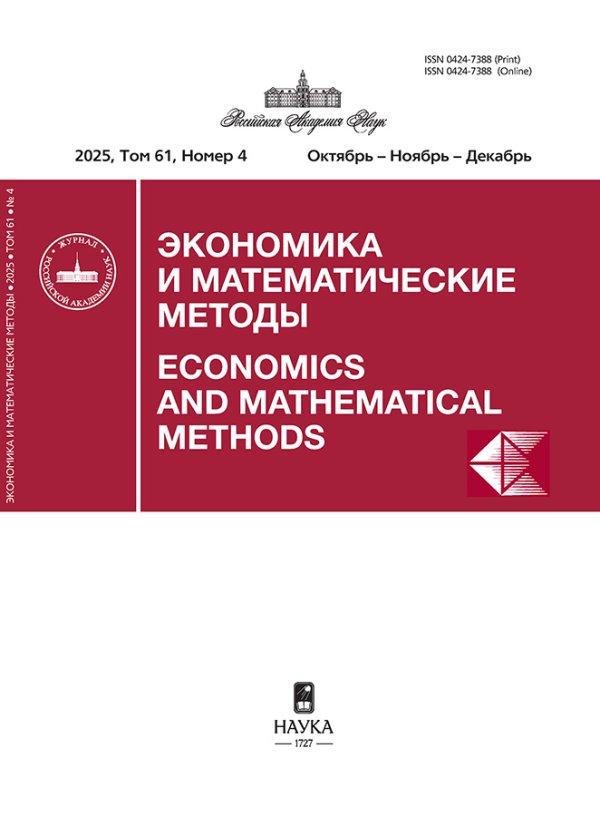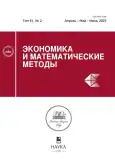Феномен «экономического чуда»: осмысление исторического опыта
- Авторы: Устюжанин В.Л.1
-
Учреждения:
- ЦЭМИ РАН
- Выпуск: Том 61, № 2 (2025)
- Страницы: 19-30
- Раздел: Мировая экономика
- URL: https://vestnik.nvsu.ru/0424-7388/article/view/684347
- DOI: https://doi.org/10.31857/S0424738825020023
- ID: 684347
Цитировать
Полный текст
Аннотация
В статье приведен сравнительный анализ экономических стратегий различных государств, которые на протяжении длительного периода демонстрировали высокие темпы экономического роста. Выборка состоит из стран Европы, Азии, Северной и Южной Америки. Период анализа — 90 лет, начиная с 1933 г. и заканчивая 2019 г. Дано описание основных инструментов, которые были применены для осуществления экономического прорыва и выхода на новые траектории развития. Проведенное исследование свидетельствует о том, что в разное время в разных странах эффективными оказывались противоположные решения. Одни государства усиливали государственное регулирование экономики, другие брали курс на либерализацию экономических связей. В одних странах происходила концентрация производства и монополизация рынков, в других упор делался на поддержку малого и среднего бизнеса. Где-то права трудящихся расширялись, а где-то ограничивались. Поэтому далеко не всегда корректно пытаться строить свою экономическую систему по чужим лекалам, копировать чужой, пусть даже позитивный, опыт для стимулирования социально-экономического и технологического развитий. Верность данной гипотезы подтверждается путем изучения исторического опыта тринадцати стран. Вместе с тем можно выделить некоторые общие черты, присущие всем странам, сумевшим продемонстрировать продолжительный экономический рост. К ним относятся: экспансионистская макроэкономическая политика, поддержка ключевых отраслей народного хозяйства (в первую очередь — сельского хозяйства и тяжелой промышленности), внедрение прорывных и инкрементальных инноваций, инвестиции в развитие инфраструктуры, стимулирование экспорта, а также вложения в социальный капитал в целях усиления сплоченности нации.
Полный текст
Об авторах
В. Л. Устюжанин
ЦЭМИ РАН
Автор, ответственный за переписку.
Email: vladimir-ustyuzhanin@rambler.ru
Россия, Москва
Список литературы
- Бутаков Д. Д., Золотаренко Е. Д., Рыбалко Г. П. (1987). Валюты стран мира: Справочник. Под ред. С. М. Борисова, Г. П. Рыбалко, О. В. Можайскова. М.: Финансы и статистика. [Butakov D. D., Zolotarenko E. D., Rybalko G. P. (1987). Currencies of the countries of the world: A reference guide. S.M. Borisov, G.P. Rybalko, O.V. Mozhaiskov (eds.). Moscow: Finansy i Statistika (in Russian).]
- Валлерстайн И. (2003). После либерализма. Пер. М. М. Гурвица, П. М. Кудюкина, П. В. Феденко. Под ред. Б. Ю. Кагарлицкого. М.: Едиториал УРСС. [Wallerstein I. (2003). After liberalism. Trans. from English by M. M. Hurvits, P. M. Kudyukin, P. V. Fedenko. B.Yu. Kagarlitsky (ed.). Moscow: Editorial URSS (in Russian).]
- Дементьев В. Е. (2002). Современные теоретические представления о факторах экономического роста. Управление социально-экономическим развитием России: концепции, цели, механизмы. М.: Экономика. [Dementiev V. E. (2002). Modern theoretical ideas about factors of economic growth. Management of socio-economic development of Russia: Concepts, goals, mechanisms. Moscow: Ekonomika (in Russian).]
- Дементьев В. Е. (2024). Сотрудничество государства и бизнеса при прогнозировании и планировании структурных сдвигов в экономике // Проблемы прогнозирования. № 3 (204). C. 18–29. [Dementiev V. E. (2024). Cooperation between the state and business in forecasting and planning structural changes in the economy. Studies on Russian Economic Development, 3 (204). 18–29 (in Russian).]
- Дементьев В. Е., Устюжанин В. Л., Устюжанина Е. В. (2024). Социально-экономическая политика государства в кризисные периоды: исторический экскурс и некоторые выводы // Terra Economicus. Т. 22. № 1. С. 6–19. [Dementiev V. E., Ustyuzhanin V. L., Ustyuzhanina E. V. (2024). Socio-economic public policy in times of crises: historical overview and some implications. Terra Economicus, 22 (1), 6–19 (in Russian).]
- Дементьев В. Е. (1998). Финансовые и имущественные основания стратегических преимуществ ФПГ. М.: ЦЭМИ РАН. [Dementiev V. E. (1998). Financial and property grounds for strategic advantages of the FIGs. Moscow: CEMI RAS (in Russian).]
- Полтерович В. М. (2023). Догоняющее развитие в условиях санкций: стратегия позитивного сотрудничества // Terra Economicus. Т. 21. № 3. С. 6–16. [Polterovich V. M. (2023). Catching-up development under sanctions: The strategy of positive collaboration. Terra Economicus, 21 (3), 6–16 (in Russian).]
- Худокормов А. Г. (2019). «Экономическое чудо» во Франции: формирование и результаты дирижистской модели в 1944–1973 годах // Мир новой экономики. Т. 13. № 2. С. 55–69. [Khudokormov A. G. (2019). “Economic miracle” in France: Formation and results of the dirigisme model in 1944–1973. The World of the New Economy, 13 (2), 55–69 (in Russian).]
- Alt P., Schneider M. (1962). West Germany’s “Economic Miracle”. Science & Society, 26 (1), 46–57.
- Beckley M., Horiuchi Y., Miller J. M. (2018). America’s role in the making of Japan’s economic miracle. Journal of East Asian Studies, 18 (1), 1–21.
- Black M. (2012). Miracles in the shadow of the economic miracle: The “supernatural ’50s” in West Germany. The Journal of Modern History, 84 (33), 833–860.
- Bloom D. E., Williamson J. G. (1998). Demographic transitions and economic miracles in emerging Asia. World Bank Economic Review, 12 (3), 419–455.
- China’s great economic transformation (2008). L. Brandt, T.G. Rawski (eds.). Cambridge: Cambridge University Press.
- Cai H., Treisman D. (2006). Did government decentralization cause China’s economic miracle? World Politics, 58 (4), 505–535. doi: 10.1353/wp.2007.0005
- Castronovo V. (2012). 1960: Il Miracolo Economico. Rome, Bari: Laterza Editori.
- Cline H. F. (1962). Mexico: Revolution to evolution, 1940–1960. Oxford: Oxford University Press.
- Crawford R. J. (1998). Reinterpreting the Japanese economic miracle. Harvard Business Review, 1, 179–184.
- Di Martino P., Vasta M. (2018). Reassessing the Italian “economic miracle. The Business History Review, 92 (2), 281–306.
- Gabrielli P. (2011). Anni di novità e di grandi cose. Il boom economico fra tradizione e cambiamento. Bologna: Il Mulino.
- Irwin D. A. (2023). Economic ideas and Taiwan’s shift to export promotion in the 1950s. The World Economy, 46 (4), 969–990.
- Lee M., Liu B., Wang P. (1994). Growth and equity with endogenous human capital: Taiwan’s economic miracle revisited. Southern Economic Journal, 61 (2), 435–444.
- Leonardi A., Cova A. (1997). Il novecento economico Italiano-Dalla grande guerra al miracolo economico. Parma: Monduzzi Editore.
- Lindlar L. (1997). Das mißverstandene Wirtschaftswunder. Westdeutschland und die westeuropäische Nachkriegsprosperität. Tübingen: Mohr Siebeck.
- Lucas R. E. Jr. (1988). On the mechanics of economic development. Journal of Monetary Economics, 22 (1), 3–42.
- Mishima T. (2004). Revision of Japan’s basic law on agriculture and its features — improvement of food self-sufficiency ratio and agricultural price policy. Hokkaido University.
- Nelson R. R., Pack H. (1999). The Asian miracle and modern growth theory. The Economic Journal, 109 (457), 416–436.
- North D. C. (1990). Institutions, institutional change and economic performance. Cambridge: Cambridge University Press.
- Page J. (1994). The East Asian miracle: Four lessons for development policy. NBER Macroeconomics Annual, 9, 269–273.
- Patrick H., Rosovsky H. (1976). Asia’s new giant: How the Japanese economy works. The Brookings Bulletin, 13 (1), 4–7.
- Smellow E. N. (1990). Zaibatsu: A study of Japanese combines yesterday and today. Washington: George Washington University.
- Struve W. (1963). West Germany’s economic miracle. Current History, 44 (260), 231–236.
- Takada M. (1999). Japan’s economic miracle: Underlying factors and strategies for the growth. Bethlehem: Lehigh.edu.
- Tolliday S. W. (2000). Introduction: Enterprise and state in the Italian “economic miracle”. Enterprise & Society, 1 (2), 241–248.
- Toussaint E. (2006). South Korea: The miracle unmasked. Economic and Political Weekly, 41 (39), 4211–4219.
- Unger J., Chan A. (2015). State corporatism and business associations in China: A comparison with earlier emerging economies of East Asia. International Journal of Emerging Markets, 10 (2), 178–193.
- Weber F. (2011). Verstaatlichung und privatisierung in Österreich 1946–1986. Zeitschrift für Öffentliche und Gemeinwirtschaftliche Unternehmen, 34 (2), 126–147.
Дополнительные файлы














